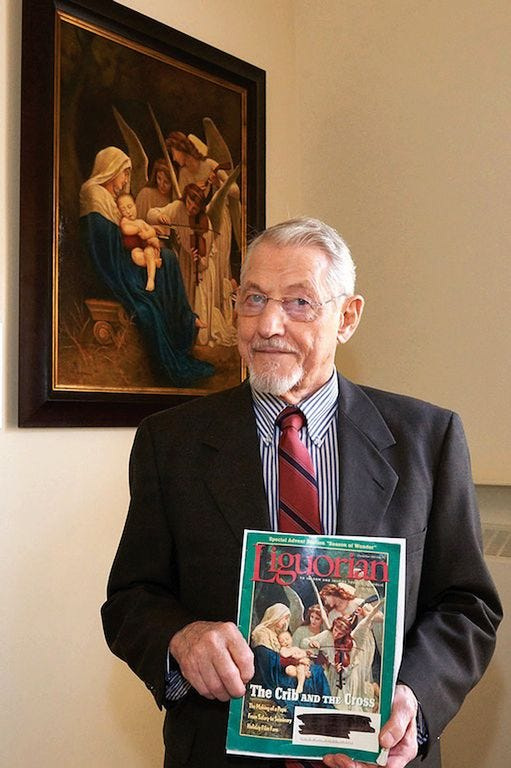Octogenarian Frank Dale has become something of an artistic icon in the general Stark County community, and with his recent passing, will be affectionately remembered by his modest cadre of exceptional students, and the many art lovers who appreciated his artistic gift.
His Renaissance-inspired paintings appeared in many regional art exhibitions, frequently carrying off top awards and are to be found in many regional art museums and private collections.

Unlike the one- or two-semester art classes taught in the universities, Frank restricted his art classes to one or two students at a time, preferring instead to meet in the “upper loft” of his Massillon residence.
His classes tended to last as long as two to three hours, and thus his schedule was booked almost every day of the week from early morning, sometimes late into the night. Some students studied with Frank for many years, “as long as we get along,” he would say.
Frank’s house was a well-kept, white middle-class frame structure like the others in the Massillon neighborhood, but that sense of similarity on the outside was quickly dispelled just as soon as one enters the living room, crowded on all sides with paintings framed and unframed, many others tightly arranged on the walls, lined up on the floor three or four deep. There was hardly enough room for a couch and two sofa chairs, well-worn but comfortable.
Students — and curious visitors — made their way upstairs to Frank’s studio, a tiny chamber hardly 10- or 12-feet square, walls lined with shelves burdened with all the paraphernalia essential to artistic creativity — bottles and tubes of pigments, brushes of every size, canvas — and the prevailing fragrance of turpentine.
Frank often talked about a spirit which haunted this room for many years, an intimate spectral friend and his greatest artistic inspiration, the Dutch painter by the name of Jan van der Meer van Delft, who has predeceased Frank by almost 260 years.
It comes as no surprise that many of Frank’s paintings recall the style and technique — even the subject matter — of this very person, known to us today as Jan Vermeer. And in his profound admiration for this great master, Frank had undertaken the mind-boggling obsession of reproducing to scale every known Vermeer painting in existence: a total of 35 works.
But fate and circumstance delayed Frank’s creative “explosion” until well into the prime of his senior years. He was born Dec. 2, 1933, in the dark days of the Great Depression, on the back porch of a farmhouse in Minatare, Nebraska. His parents, young and naïve teenagers already possessed with another son, moved from place to place in search of elusive jobs, often living in conditions of abject poverty.
When Frank was 9 years old, he was the victim of a terrible accident, when he and another boy tried lighting a fire by pouring gasoline from a large tank on dying embers. The tank exploded, spraying Frank’s trousers with the fuel, severely burning both legs.
Frank was hospitalized for many weeks, enduring painful treatments and numerous operations over the years, unable to attend school during long periods of recovery. With his youthful interest in art, Frank managed to advance his talents through preliminary drawings and sketches.
After high school in 1951, Frank attended Brigham Young University on a scholarship and continued his studies at Santa Rosa Junior College in September 1954. Frank landed a job in a medical facility, moving to San Francisco where the art scene was far more active.
Now with access to several major art museums, Frank had a firsthand opportunity to view original paintings by the great masters and he continued his education.
But as Frank broadened his art experiences in diversified fields, he was constantly disappointed with his professors and disenchanted with the contemporary art scene.
Abandoning college studies, Frank turned to museums and libraries to enrich his education, finally making up his mind to discover for himself the secrets of the artists he most respected, the Renaissance Masters.
But then, his life got complicated. Frank met a lovely girl named Leitzel, and the two were married in 1961. Because of familial demands, Frank set aside his painting ambitions for more than 20 years, working at various odd jobs.
An important job opportunity with a meat packing corporation brought him to Massillon and to the white house on Fourth Street.
In 1986, Frank and his wife agreed to a dissolution. Frank resumed his search for the elusive medium which would enable him to paint like the Dutch Masters: Rubens, Rembrandt, and Vermeer. Based on Frank’s special fondness for Vermeer’s work, he decided that “he will be my teacher.”
Unfortunately, this artist left no description of his actual methods. Frank’s research extended to rare, obscure and hard to find books on secret paint formulas, special glazes and varnishes, and other rare ingredients. He read and studied them all, duplicated their formulas, and with time, had mastered the most ancient techniques of the great Renaissance artists.
Frank joined the Canton Museum of Art in 1995 as an art instructor, bringing his work to the attention of a larger audience. Frank had already completed two Vermeers based on illustrations in books, but now he wanted to see how his colors compared with the originals.
While paging through a two-volume study of Vermeer’s life and work, Frank’s curiosity was stimulated by this artist’s rendering of “Girl with the Pearl Earring.”
That curiosity was satisfied with a visit to an exhibition at the National Gallery of Art in Washington, D.C., where all the extant Vermeer paintings were being shown.
Frank’s first version of “The Girl” was followed by a second, “somewhat better, but not quite right.” But a third, based on a superior color-print reproduction, he proudly boasted, was “right on.” Gratified with these results, Frank was inspired by an insane idea, and he decided, “What the Hell. Why not do them all?”
Insane indeed! There are 35 … how long would such an overwhelming project take? Would he live long enough?
Frank first tackled the small Vermeers, completing about 15.
When these were exhibited at several mall venues and group shows, the positive response motivated him to pursue his seemingly impossible dream.
At the art museums in Canton, North Canton and Massillon, Frank gained considerable recognition, often carrying off top awards. Students in large numbers began signing up for private classes, determined to learn the hard-won artistic secrets from this reincarnated master.
Frank retired from his full-time job in 1998 and dedicated himself to Vermeer.
So now, with the aid of all his books and artistic materials, his Massillon home became a multi-room gallery of his paintings and those of his students.
In his basement, Frank had assembled a kind of medieval laboratory where he experimented with the various recipes and formulas gleaned through his research, recreating the original Renaissance formulas hidden in secrecy, or lost through the ages.
After several years of many trials with different combinations of resins and oils, Frank settled on his own original formula.
Frank was invited in 2013 to present an exhibition of some of his own original works, along with those of several of his students at North Canton’s Little Gallery, appropriately titled “Flemish Pearls.” Among Frank’s entries was his proudest achievement, Vermeer’s “Girl with the Pearl Earring,” which admiring gallery visitors described as “uncanny,” “a close match to the original.”
Having finished more than two-thirds of the total Vermeer oeuvre, Frank optimistically calculated that he could complete the remainder in time for a projected premiere exhibition opening in November 2018. But with recurrent episodes of previous afflictions, Frank was forced to substitute a number of “works in progress.”
With Frank’s recent passing, what will happen to all his Vermeers now that the project is finished? The last time I spoke with Frank, I complimented him on his long and productive life. He had only this to say: “My life here is perfect. It’s a wonderful trip that I’m on.”
While that trip has ended, Frank leaves behind a formidable body of students whose artistic lives have been enriched by their experiences with him.
M.J. Albacete is executive director emeritus with the Canton Museum of Art and retired adjunct art professor (retired) at the Kent State University Stark campus.
This article originally appeared on The Repository: Gifted Massillon painter inspired formidable legion of artists | Opinion
Reporting by M.J. Albacete / The Repository
USA TODAY Network via Reuters Connect



